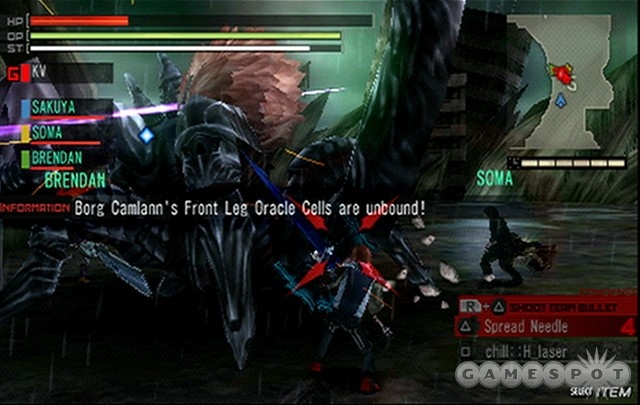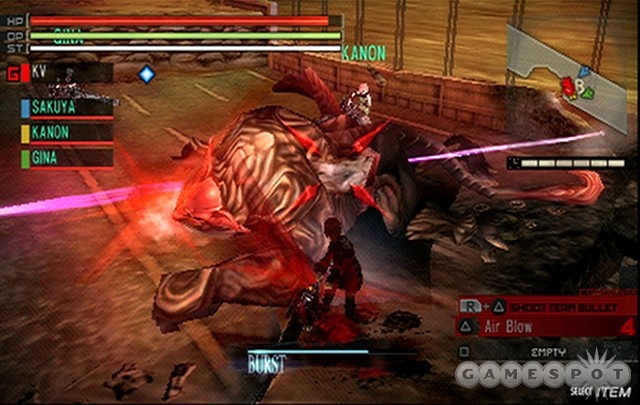If you've played a Monster Hunter game, you would naturally compare it to Gods Eater Burst. In both cases, you join your chums and do battle with gargantuan creatures that take away large chunks of your health with a single swipe of their massive tails, or with a single bite from their gnashing teeth. In between battles, you use monster bits and other items you've gathered to create new weapons or upgrade those already in your possession, in turn making it possible to take on even bigger, badder fiends. But while comparisons are inevitable, dismissing Gods Eater Burst as a mere clone would be doing this enjoyable game a disservice. Eerie, attractive environments make it a pleasure to stalk your ferocious targets, and being able to quickly switch between ranged and melee weapons grants your hunts intensity. Not every facet of this action/role-playing hybrid is a winner. A cumbersome camera and control scheme can get in the way, and the condensed structure will have you longing for more gameplay variety. These and other flaws notwithstanding, it's hard to deny the appeal of joining some real-world or computer-controlled comrades and cutting a roaring brute down to size.
Gods Eater Burst takes place on Earth, but it isn't an Earth you would recognize. The planet has been ravaged by mutant beasts called aragami, and an organization called Fenrir has made it its mission to wipe them from the planet. Fenrir's goals aren't always so noble and pure, however, and as the game progresses, you learn more about their scientific studies on the creatures that roam the land. At first, you aren't likely to be invested in the story, or in the role-playing archetypes that inhabit it. Among them are the overeager, histrionic adolescent; the sighing ingenue hiding a terrible secret (as all such characters must); and the faux-mysterious, spiky-haired sulk who keeps his teammates at arm's length. Each character is enthusiastically and inexpertly voiced by a cast that knows no subtlety, going heavy on the whimpers, chirps, and breathless line deliveries. Awkward characters aside, the plot takes enough twists and turns to get you interested in this world and its enigmas. Who is the gaunt, ghostly figure glimpsed on the battlefield? What is the meaning behind a newcomer's visions? What exactly is Fenrir looking for out in the howling wastes? The answers often lead to more intriguing questions--enough to see this tale to the end.
Those characters are the Gods Eaters, though irritatingly, while the game's subtitles all use the phrase "Gods Eater," the spoken dialogue is always delivered in the singular: "God Eater." Armed with weapons created from the very DNA of the monsters you hunt, you and up to three companions head into the bleak landscape to hound your enemies and scavenge for raw resources. These environments are all attractive and in some cases rather haunting. Pockmarked skyscrapers loom above you, a reminder of the civilization that once stood there. Falling rain and cloudy, turquoise skies provide a menacing backdrop to the tense battles that transpire. The aurora borealis stretches across the heavens in one snowy map; glowing lava is a sinister touch in another. As you jog across these stretches searching for your quarry, an eerie howl fills your heart with dread. The presentation is excellent, and unlike in similar games, you move freely about each battlefield without any intrusive loading times. It's unfortunate that your dozens upon dozens of missions occur on a relatively small number of maps. Fortunately, repetition is at least partially relieved by the visual diversity among Gods Eater Burst's atmospheric environments.

The high visual quality and diversity carry over to the beasts you fight, some of which have characteristics of real-world creatures, and others of which seem almost demonic in origin. One aragami looks and acts somewhat like a giant scorpion, but when it shields its face with a creepy skeleton mask, you know it's no simple arachnid. A gorgeous, toxic angel takes to the skies, emitting poisonous dust--half beautiful butterfly, half shrieking spirit. You won't see any indications of a living ecosystem as you might in a Monster Hunter game, so fans of that series might miss that touch of authenticity. Yet Gods Eater Burst makes up for this loss with the pure inventiveness of the aragami designs and behavior. You fight the same creatures time and again, though you meet new ones as you progress, while familiar ones learn new attacks and come in variants that are more vulnerable to certain attacks than others. Early on, you might take on one at a time, but missions mix things up later, sometimes requiring you to fell a large number of simpler foes, or sometimes throwing two, three, or even more massive monsters at you at once.
Of course, you aren't helpless in the face of such insurmountable odds. Mission descriptions indicate any aragami weaknesses, so you know which type of weapon might be best to equip before heading out. You fill three different equipment slots: melee weapon, shield, and gun. Melee weapons come in various flavors. Some are heavy and slow, but do good amounts of crushing or piercing damage. Others are quicker, and might have elemental properties, using ice and fire to wound your prey. Guns have their own sets of statistics, and you can purchase (and later, craft) specific types of bullets with similar elemental properties. In battle, you can switch between your melee and ranged weapons at will, but there's a catch: you can't just fire bullets willy-nilly. Rather, your ability to shoot is limited by a meter that is filled by landing melee attacks. In this way, Gods Eater Burst not only reduces the possibility of exploiting guns, but also gives combat variety by letting you both slice and shoot in a single mission.
Battles are uniformly intense. You generally get 30 minutes to complete a mission, and while it is rare to fail because the timer runs out, a single confrontation can take up a good chunk of that allotment. Aragami charge at you, spew rockets, and belly flop, among the many different attacks they deliver. Battles have a careful but smooth rhythm and require a lot of focus, since a single attack might wipe away a good portion of your health bar. If you find battles like this frustrating in similar games, you may find Gods Eater Burst's tweaks to the formula welcoming. For example, quaffing a health tonic and setting traps are brief affairs, so while you still make yourself vulnerable when performing such actions, you don't have to wait through overly long animations, nervously hoping to stay alive. Your attention is instead directed toward avoiding attacks, landing blows, and devouring your oversized targets with your weapon, which is also known as a god arc.
Yes, indeed: devouring. By holding the strong attack button, you transform your melee weapon into a set of beastly jaws that chomp on a creature. When the monster is already defeated, this earns you creature parts that are used at your home base to create and improve weapons and shields. If you successfully land a devour when the beast is still alive, you enter burst mode. This grants you a short period of time in which you do extra damage and get other special abilities, such as being able to double jump. It also gives you a limited number of special bullets that do a type of damage consistent with the monster you attacked. For example, a monster that performs lightning-type attacks will grant you a torpedo that causes spark damage. Devouring a creature is rewarding: blood spews all over the screen, your weapon's transformation looks and sounds gross and creepy, and because the chomp takes a few precious seconds to accomplish, the risk is appropriately balanced to the reward your earn.

It's too bad that several drawbacks inhibit the joy of squashing these tyrants. Happily, you can lock on to aragami while using a melee weapon, making it easier to keep track of them than it otherwise would be. However, when there are more than one onscreen at a time, you might inadvertently lock on to a more distant foe, complicating the fight and forcing you to fiddle with the controls. There is no such mechanism when taking aim with a gun. Experienced monster hunters will get use out of the so-called "claw technique" here, which involves keeping your thumb on the analog nub and manipulating the camera by using your index finger on the D pad. You can center your view with a shoulder button, but lining up a shot when dealing with a rowdy monster or three can be a big hassle, especially in areas that don't give you a lot of breathing room.
The camera and control aggravations are usually mild, but they become more pronounced in major battles late in the game, when multiple powerful aragami bombard you with constant attacks and make it almost impossible to isolate a single target from the pack. You can revive a fallen teammate by donating half of your health to him or her, which is a great feature that keeps you in the thick of battle. However, the most punishing scenarios have an unfortunate tendency to turn into inescapable cycles of death and revival. While you can stock up on healing items aplenty and even fire healing bullets to support your teammates, the health sacrifice taken upon each revival slowly diminishes the team's overall health reserves. You might run out the clock because you spent all of your time keeping your team alive, and little time sinking your blade into attacking monsters. There aren't too many such roadblocks, but they're exasperating when they occur.

At Fenrir headquarters you can talk to key story figures, but they might have only a quip or two to share. Otherwise, you can buy key items from the merchant, or see if you have gathered enough ingredients to upgrade your equipment or perhaps create something new. Compared to similar games, this part of Gods Eater Burst seems comparatively lacking. The streamlined menus make upgrading a simple process, but there are few side activities to keep you involved outside of missions that involve fighting the same creatures time and again. You can create new clothing, but it's just cosmetic--there is no armor to don or upgrade. Farming, fishing, and other activities like those you would see in the Monster Hunter series are curiously absent. Furthermore, pre-battle preparations aren't as great a concern as they may have been. Traps, stun grenades, and other items can be handy, but they aren't always necessary when you have a full team. Gods Eater Burst is a more diluted experience than its obvious inspiration; the depth that would keep dedicated grinders invested was jettisoned in favor of an immediately accessible experience. As a result, you are likely to notice just how much of the game relies on repetition.
Yet repetition isn't inherently bad, and while tedium can set in, Gods Eater Burst's ever-evolving monster behavior keeps you on your toes. If you prefer to replace your AI companions with a friend or three via ad hoc play, the game makes it easy to join up, though you'll want to stick with players of around the same level for the best experience. It's nice, however, that you still get that sense of camaraderie if you venture out on your own, thanks to the generally dependable AI. Of course, if you're a veteran of such games, you might want to leave companions behind whenever possible for the extra challenge. Such challenges won't be to everyone's taste, and are often magnified by a camera and controls that don't take into account the strengths and weaknesses of the platform. But enjoyable battles and a strange and sinister atmosphere make Gods Eater Burst a worthwhile reason to gather up your buddies and start an adventure.
